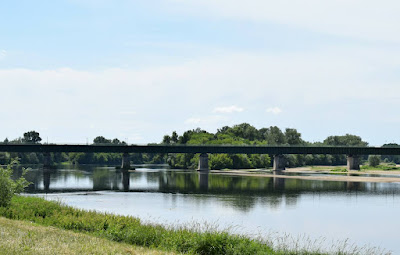The last blog wrongly stated Briare was 10 miles down the Loire. It’s 10 miles up the Loire, where our campsite takes your canoe so you can float down to Gien. It’s not as photogenic as Gien but it does have the longest canal aqueduct in Europe, built by M. Eiffel of Tower fame. It’s not as impressive as our Llangollen canal aqueduct but here it is, as it crosses the Loire, looking much like a sewerage pipeline.
Looking round from the aqueduct, we spotted a familiar contraption on the opposite bank. It’s the gypsy caravan with the young lad apparently sat on a chair in the river.
There are several canal systems meeting here. They are clearly much more reliable than the Loire for both leisure and transport, and are quite scenic.
It was built between 1890 and 1895, financed by the local
enamel factory magnate. It was designed in the Byzantine style, like eastern
European or Russian churches, because they are decorated in a way that the
benefactor could display lots of enamel work. A closer look at part of the
façade shows this treatment on the patterning over the doors and in the arches
on the next level up.
Inside, the floors show eastern pattern design but not sure
if it’s enamelwork?
The whole effect is of another time and place, but it is a
regular Catholic church.
No more churches for a while, at least until the next blog!
We headed then back to the campsite to prepare for moving off tomorrow for
Abbeville, our last stop before home.






































